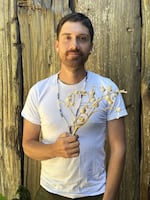Tribes across Oregon are reigniting their relationship with tobacco. Not just any tobacco, but the very kind their ancestors grew and used before colonization and the fur trade.

In a video taken at the 2023 Sacred Tobacco and Traditional Medicine Gathering near Bend, several members of Native American tribes or groups hold a jar containing Columbian tobacco. This strain of tobacco disappeared from the Pacific Northwest in the 1800s and was feared lost.
Courtesy of Desiree Acosta/KLCC
And this plant is making its comeback after being gone for nearly two centuries.
It’s a sunny day at Gregory Point on the Oregon Coast, though to the Confederated Tribes of Coos, Lower Umpqua, and Siuslaw Indians (CLUSI), this windswept place of rock, surf, and greenery is called Baldich.
Ceremonies are often held here. Tribal member Mark Petrie says one of these is the salmon ceremony, which involves remnants of a salmon feast.
“And so out here we return those salmon remains to the water, to the salmon people, respect for them and what they bring us,” he explains. “And also ask them to come back next year to feed our people and continue that long-standing relationship we’ve had with them for so long.”
Petrie adds sacred tobacco is also offered.

Gregory Point, Oregon. The Confederated Tribes of Coos, Lower Umpqua, and Siuslaw Indians call this area Baldich, and use it for gatherings and ceremonies.
Brian Bull / KLCC
Joining us is Nicole Romine, the CLUSI Tribal Tobacco Prevention Program Assistant. As we navigate a rocky trail with seagulls and cormorants swooping overhead, she carries a jar filled with greenish-tan leaves.
“This is actually some of our first harvested tobacco,” says Romine. “I was just going to do a little blessing here with you guys and bless our stories.”
I don’t record the blessing, as some Native practices are to be experienced only in the moment. But what Romine and Petrie are more than happy to share, is that this type of tobacco is called Nicotiana quadrivalis variety multivalvis, or Columbian tobacco.
Back at the tribe’s plankhouse in Coos Bay, Petrie says this tobacco was grown by tribal biologist John Schaefer a few years ago after a lengthy quest — a quest that began in 1825, on the banks of the Columbia River.
“There was a man who came through, a botanist, David Douglas, looking for special plants to take back to the Royal Horticultural Society,” said Petrie. “And so he heard about the sacred tobacco that the tribes were growing right next to their plank houses.”
Douglas was intrigued with the Natives’ sacred tobacco, but was rebuked when he asked to take some seeds back to London. So he took to more devious means.
“He came by way of night and took some seeds,” continues Petrie. “(He) was caught, talked his way out of it, traded some other tobacco and I’m sure other things for the seeds. He got away with them.”
Through the 19th century, traditional tobacco became increasingly rare in the Pacific Northwest. Robert Kennta, former cultural director of the Confederated Tribes of Siletz Indians, says it trended out during the fur trade.
“The traditional tobacco kinda fell out of use, once the traded tobacco came into the area through Hudson Bay Company, and the ships along the coast and other sources,” Kentta explains. “To me it’s a little bit of a surprise that our elders picked it up that quick, because they had such strict protocols around tobacco having to be grown a certain way, and used a certain way.”
Those protocols eroded over generations. What was once ceremonial and practiced with care soon became a casual but addictive habit. Commercially-processed tobacco products with additives became commonplace, with many appropriating Native American imagery on their labels and advertisements.
That marketing — as well as messaging that modern smoking is “traditional” — drove up commercial tobacco use, as well as health issues in Native communities. Data from The Truth Initiative shows 16% of Native American and Alaskan high-schoolers smoke cigarettes nearly three times more than non-Indians. And Native people suffer very high rates of heart disease and cancer.
“It’s only to be used as a tool, to bring your prayers up to the Creator,” said Scott Kalama. He’s a certified prevention specialist at the Confederated Tribes in Warm Springs. He’s worked 12 years in tobacco prevention, educating his fellow Natives on commercial tobacco versus traditional tobacco.
“How the over-the-counter products have additives in it and how it’s really addictive,” he said. “I always tell them that, ‘Hey man, I know you’re out here, smoking a cigarette. But I know you’re not praying. You’re just over here using it to get that nicotine.’”
The return
In 2006, CLUSI biologist Schaefer received one strain of important tobacco seeds from Thomas Jefferson’s Monticello in Virginia. This was Nicotiana quadrivalvis variety quadrivalvis, more commonly known as Indian tobacco. But the prized Columbian tobacco seeds — the kind taken by David Douglas — remained hard to find.

Mark Petrie, a CLUSI tribal member, with the Columbian strain of tobacco. It's considered a sacred and important plant.
Brian Bull / KLCC
Then in 2017, there came word of a tobacco seed bank in central Europe.
At the tribal headquarters in Coos Bay, Romine leads me through a shed filled with drying plants and materials, including tule, sage and cedar. Near the back, she presents me with a gnarled and bulbous piece of history, Nicotiania quadrivalis variety multivalvis, the same Columbian tobacco sought for years.
“So this is the strain that made its way from the Columbia River Gorge all the way over to London, and then all the way to Pulaway, Poland,” she said.
Shaking one of the plant’s seed pods, Romine says Schaefer managed to have the Columbian tobacco seeds shipped from Poland that same year, ending the hunt for the tobacco planted and used by Pacific Northwest tribes.
There are more plants being raised in the tribe’s nearby greenhouse, not just for the Confederated Tribes of Coos, Lower Umpqua, and Siuslaw Indians, but for others.
Sharing what was once lost
This past May at the Sun River Resort in central Oregon, an event called the Sacred Tobacco and Traditional Medicine Gathering was held. Petrie and others gifted the recovered Columbian Tobacco to several Native American groups and the other eight federally-recognized tribes within Oregon’s boundaries.
Petrie says it was good medicine to see tribes reconnect with the tobacco.

In a video from May 2023, Mark Petrie shakes hands with members of NARA NW Portland, after gifting them CLUSI's traditional tobacco. The Columbian variety was absent from the region — perhaps the entire U.S. — for nearly two centuries.
Courtesy of Desiree Acosta/KLCC
“We have been without the sacred tobacco for so long, we have it back in our ceremonies and it brings a lot of happiness to our elders, myself, our families, that we have that back with us,” he said.
The Confederated Tribes of Coos, Lower Umpqua, and Siuslaw Indians plan to have another event next year in Grand Ronde. They hope to build on the sharing of a sacred plant that was absent for nearly two centuries, and is cherished by many tribes.
Traditional tobacco versus today’s commercial product?
“The traditional tobacco, was strong. It had a big kick to it,” Siletz tribal member Robert Kentta says. “Because it was so strong, only older men really smoked it on a regular basis because they didn’t have to get things done as much throughout the day and, and whatnot. So apparently it was strong enough that it would kind of lay you out and make you unproductive for a period of time.”
Commercial tobacco is raised on large plantations, and then harvested and treated with chemical additives including nicotine. Over the past century, it’s not been unusual to see Native Americans and other Indigenous communities use it for blessings and ceremonies. But proponents of the traditional forms are hoping to eventually bring their ancestors’ tobacco back to reclaim its use, and discontinue use of the processed variety.
For Nicole Romine, the campaign is personal. “Most of my life kind of before I started my job with the tribe, my family members — many of them were smokers — chewed tobacco,” said Romine. “And so I saw the harms that befell my family members, and I’ve lost family members through the use of commercial tobacco. Lung cancer, other cancers, other early death just caused from use of commercial tobacco and alcoholism as well. So those two things had been in my life since I was a young child.”
Romine says this has guided her as she works in tobacco prevention efforts, and she said the plant holds a special place in her heart as she serves as its steward, currently. She also said tobacco is also offered whenever something is taken, such as during harvesting a plant or catching a fish.
“When we take something, we always give something back,” said Romine. “Taking something without returning doesn’t feel right for us.”
As to health concerns: Traditional tobacco isn’t used as frequently or in the same manner as cigars, cigarettes, chewing tobacco, and vaping devices.
“You may see us wearing pouches around our necks or on our hips, on our belts,” said Petrie. “We have leather pouches, medicine bags, if you will. And we have a lot of our members that carry our secret tobacco with them in that way.
“And it is a dried form of the plant that is not necessarily dried to retain the nicotine that’s in the plant, because our goal isn’t to have the highest amount of nicotine in there, it’s not for consumption or use in that way. We use it more for our ceremonies or dances and our gathering practices when we go out.”
Petrie said the traditional tobacco was often put into clay pipes, and smoked while laying on one’s back. He told KLCC at this point that this was as much as he felt comfortable sharing tribal practices with their ancestor’s tobacco, given its sacred nature.
Petrie did add that care was taken not to overuse the plant, and making it a habit was discouraged.
“It was actually noted in some of our histories that there was a term for somebody that did become addicted to tobacco, and that was a very derogatory term and it was very much frowned upon,” he said. “And if any of the members did use the tobacco in a way that was more habitual, more addiction-based, they would need some help.”